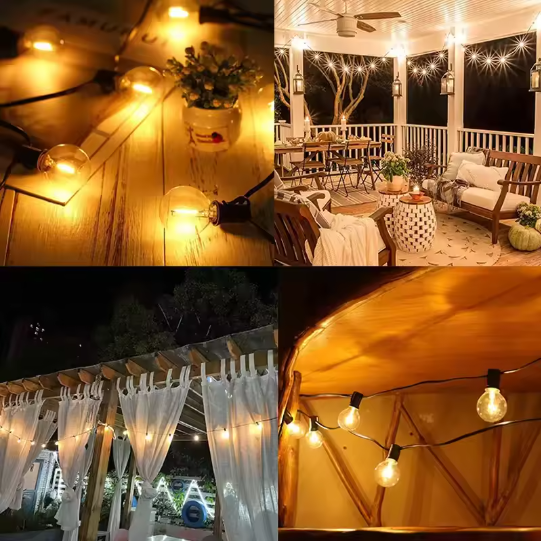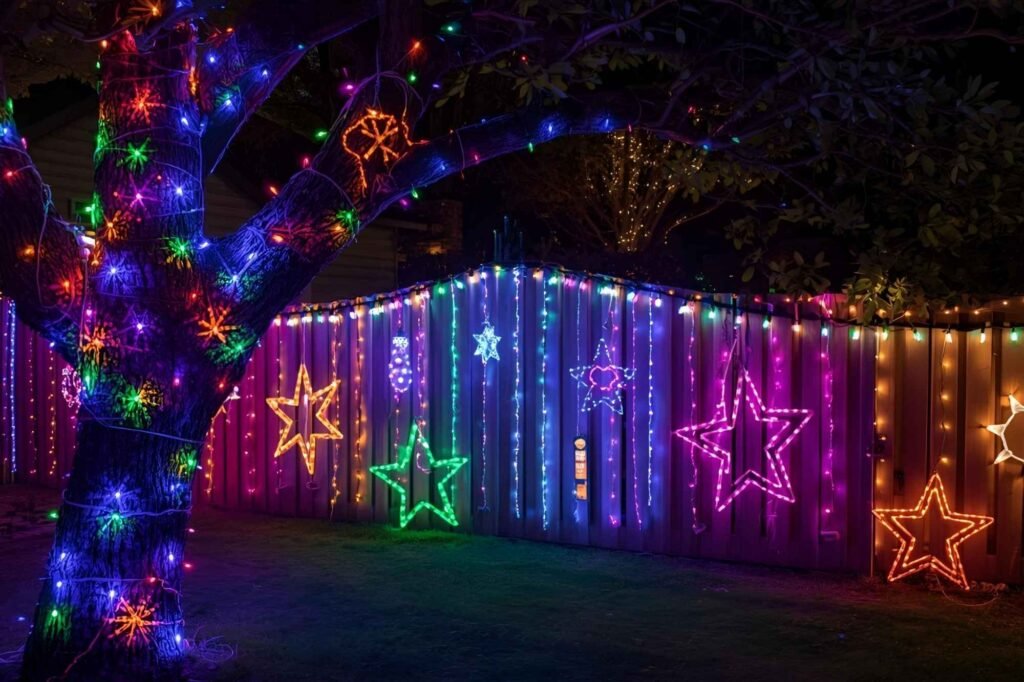Market: United States
Season: Winter/Christmas
This analysis outlines the technology choices, lighting design methods, cost controls, and maintenance protocols that consistently deliver reliable winter garden Christmas lighting in U.S. climates.
Seasonal context and market trend
U.S. households increase outdoor lighting hours by 30–60% during the holiday window from Thanksgiving to New Year’s Day. Energy and reliability therefore become decisive. LEDs dominate due to efficacy and durability, while solar solutions have expanded market share in regions with favorable winter insolation. Category pages list broad decorative options under garden lights and solar‑specific models under Solar Garden Light, reflecting demand for string lights, pathway markers, and patio strands.
Ingress protection: IP65–IP67 for exposed fixtures
Operating temp: down to −20 °C for northern states
Design strategy: coherence, hierarchy, and glare control
- Coherence: select a single white point per visual zone; mix warm and cool only with intent for layered contrast.
- Hierarchy: identify three to five focal elements—entry, evergreen, pergola, façade—then use accent beams or string light clusters to establish a clear visual path from curb to door.
- Glare control: snow can push ground reflectance above 0.6. Shield emitters, use frosted caps near eye level, and dim after fresh snowfall to avoid veiling reflections.
- Wayfinding: path averages of 0.5–2.0 fc with ≤10:1 uniformity guide guests while preserving dark adaptation for views of decorations.
Electrical architectures: wired low‑voltage vs. solar self‑powered
Low‑voltage 12V systems
- Strengths: high peak output, precise dimming, reliable dusk‑to‑dawn in cloudy belts.
- Specs to request: magnetic or electronic transformers with multi‑tap outputs; keep end‑of‑run voltage ≥10.8 V; surge protection for long exterior runs.
- Best uses: façades, tall trees, and large installations with synchronized effects.
Solar heads for holiday layouts
- Strengths: no trenching, rapid install on pergolas and paths, zero utility energy cost.
- Winter performance: modern LiFePO4 batteries with MPPT charging can provide full‑evening runtime in mid‑latitude states when panels are clean and tilted.
- Best uses: remote corners, rental properties, and temporary holiday scenes.
For model exploration, see Solar Garden Light.
Image reference: warm white decorative scenes

Optics and color: reading the winter palette
Warm white at 2700–3000K renders skin tones and timber neutrally and keeps metallic ornaments rich. Cool whites in the 4000–5000K range pop against snow and ice but can look clinical near brick or cedar. CRI values of 90 or higher keep reds and greens saturated for holiday decor. Beam selection matters: 10–25° accent beams sculpt conifers; diffuse caps on path heads prevent sparkle glare on snow.
Quantified comparison: runtime and energy
| U.S. city | Peak sun hours in Dec–Jan | Solar head runtime (3 W lamp, LiFePO4, MPPT) | 12V wired energy for 10 heads (3 W each, 6 hours/night) |
|---|---|---|---|
| Phoenix, AZ | 4.5–5.5 | 10–12 h | 1.8 kWh/month |
| Atlanta, GA | 3.5–4.5 | 8–11 h | 1.8 kWh/month |
| Chicago, IL | 2.2–3.0 | 6–9 h | 1.8 kWh/month |
| Seattle, WA | 1.3–2.0 | 4–7 h | 1.8 kWh/month |
| Burlington, VT | 1.8–2.5 | 5–8 h | 1.8 kWh/month |
| Assumes clean panels, battery at 0 °C, and 18 h/day average darkness in deep winter. Wired energy assumes 30 W total for 6 h/night, 30 nights. | |||
Safety, codes, and durability in winter conditions
- Ingress protection: IP67 for exposed bollards and path heads near sprinklers or plow splash; IP65 acceptable under covered porches.
- GFCI protection: required for outdoor receptacles; use in‑use covers to protect plugs from snow melt.
- Cable practices: drip loops at all entries; elevate splices above mulch; use gel‑filled connectors for 12V lines.
- Slip and trip: avoid mirrored path pairings that create tunnel glare; space 6–8 ft on center with alternating offsets.
Decor archetypes that perform consistently
Entry and porch
- Warm‑white strings under eaves; 2700K downlights at low output to preserve contrast with decor.
- Timers: sunset to 22:00 at 100%, then 40–60% to sunrise.
Trees and plantings
- Cross‑light conifers with 10–25° beams; keep sources out of common viewing angles.
- Use green/red filters sparingly; color washes read strongest on snow or light bark.
Paths and steps
- Frosted caps and louvers reduce sparkle; consider solar markers in remote segments.
- Supplement with shielded step lights where ice forms.
Operations: installation and maintenance sequence
- Survey: note snow throw paths, sprinkler arcs, and existing GFCI locations.
- Layout: mark hierarchy and cable runs; allow separate circuits for decor vs. wayfinding.
- Mount: pre‑drill fasteners; protect coatings; use stainless hardware and isolators on metal contact points.
- Seal: compression gaskets, quality cable glands, and dielectric grease on splices.
- Test: verify 0.5–2.0 fc on paths; check for direct view of emitters from key approaches.
- Commission: set astronomical timers and dimming scenes; document settings for repeat seasons.
Cost model for a 12‑fixture holiday path scene
| Architecture | Hardware | Installation labor | Monthly energy (Dec) | Runtime assurance |
|---|---|---|---|---|
| Solar heads (3 W) | $1,080–$1,680 | $360–$720 | $0 | Weather‑dependent; panel cleaning needed |
| 12V wired (3 W/ea) | $960–$1,520 + transformer $180–$320 | $720–$1,080 | $2–$4 at $0.16/kWh | High; grid supplied |
| Ranges reflect typical U.S. contractor pricing and energy averages; adjust for region and access. | ||||
When full assemblies are needed, browse Solar Garden Light or the broader garden lights catalog.
Quality indicators to check before purchase
- Ingress rating verified on spec sheet and housing markings.
- CRI and CCT disclosure; look for 2700–3000K and CRI ≥90 for premium scenes.
- Warranty terms and serviceability—replaceable lamps or modules simplify future seasons.
- Battery chemistry for solar products—LiFePO4 preferred for cycle life and cold performance.
Frequently asked questions
Citations and further reading
- U.S. DOE Solid‑State Lighting program — outdoor reliability and efficacy context: https://www.energy.gov/eere/ssl/
- Illuminating Engineering Society (IES) — residential exterior lighting practices (LP‑2, RP‑8 contexts): https://ies.org/
- NREL NSRDB — winter solar resource and insolation references: https://nsrdb.nrel.gov/
- EIA — U.S. average retail electricity prices used for cost modeling: https://www.eia.gov/
The analysis aligns with themes frequently discussed across high‑ranking U.S. landscaping and holiday lighting resources accessible via Google Search in 2024–2025; links above provide datasets and standards used for verification. Internal linking to product categories: Solar Garden Light and garden lights.


